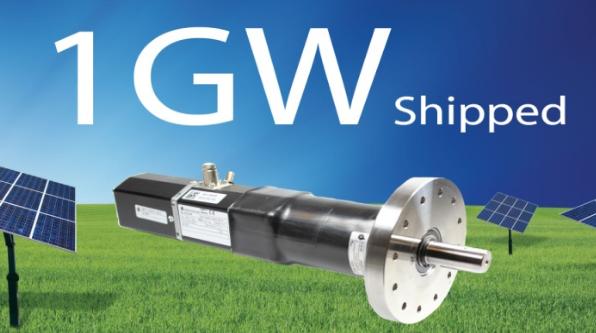Similar to the most sophisticated, highly automated and long lasting solar trackers; wind turbines too need motors and drives with similar, if not with much more stringent values.
The motor and drives must withstand higher than normal shock and vibration, high to low extreme temperatures, stormy and windy conditions both on remote land and seashores. Units need to be highly automated. Long service life, sometimes not accessible, even for normal inspection or maintenance. Equipment manufacturers, such as for motors, sensors, actuators, controllers and drives, with long and successful experience in solar trackers, understand these requirement and performance values. It is therefore not unexpected that the same manufacturers are now in the exploding market of small wind turbine application of wind energy.
Pitch control gearmotor and drive.
The pitch control for small wind turbine needs to be fast and essentially reliable. The Pitch of the turbine blades ensures at all times, the best optimum rotational speed for the turbine and this provides the best efficiency for electric power generation.
The reliability of the pitch control is critical in the event of high winds, gale or storm. In such instances, high wind would create a runaway speed condition of the turbine. This would cause series damage to the turbine. A fast and reliable pitch control system would immediately turn the blades away from the wind, reduce the blade angle and keep the turbine from over speeding. Actuators need to respond within 100ms, a change in pitch angles, with a resolution of less than 1 degree.
Servo dc brushless gearmotor with integrated electronic controls, in conjunction with reliable absolute encoder, precisely determining the blade pitch angle, is essential. The optimum rotational turbine speed is needed for efficient power generation. To keep the nacelle weight low, the demand for multiple small gearmotor drives for the pitch control is gaining popularity. To increase reliability of this operation, the need for having multiple motors connected electronically over CANbus is essential. Furthermore, this connectivity helps the speed and the load be shared and they work in unison for smooth operation.
Yaw control gearmotor and drive.
The yaw drive system of the wind turbine is the component responsible to keep the Nacelle oriented towards the path of the wind.
The Nacelle is mounted on a friction based Glide bearing and the azimuth rotation is actuated with several powerful gearmotors. A separate yaw brake unit is eliminated, if the gearmotors are equipped with fail-safe integrated brake. This is extremely cost saving and lessens the nacelle’s weight.
On recent Nacelle designs for both small and large power generators, to keep weight and cost low, the trend is to use several small gearmotors. This improves the reliability of operations too, instead one large gearmotor. With the popularity of CANbus connectivity, it is now possible to connect several motors, activating sensors to a close loop operation. This helps in all motors to start up in unison, speed control and load sharing for smooth operation. The capability of remote monitoring, recording data and analyze for early diagnostic checks, are becoming essential features of small turbine operation for uninterrupted power generation.
Dunkermotoren’s WTM (Wind Turbine Motors).
Exclusive WTM features include:
- Designed to perform in harsh environment conditions of wind and at -30 to +85ºC.
- Highest degree of integration of motor+gearbox+controller+fieldbus motion solution.
- Slewing resolution of up to 0.0002°.
- Smart and scalable on board intelligence and sensors.
- Programs remotely upgradable via CANopen network.
- Advanced lubrication techniques, enhanced for low speed high torque operating conditions.
- Environmentally sealed with shrink tubing to prevent water and moisture ingress.
- GoreTex membrane for venting trapped condensed moisture, inside the motor rear-ends.
- Power and control termination available through waterproof connectors.
- Withstand shock and vibration to EN61373 Class 1B.
- Power range up to 1100 watts. Voltage up to 110v. Peak accelerating torque up to 320 Nm.
12. Expected to last long life in solar trackers worldwide, as our STM model.
Filed Under: News





